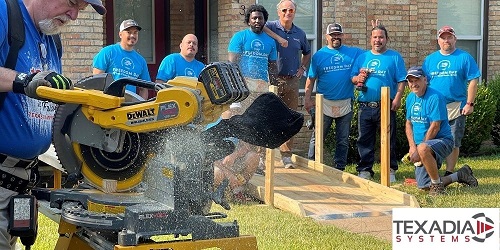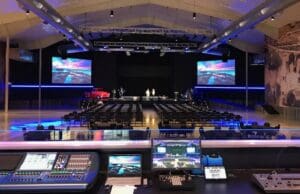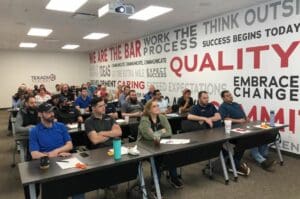
4.26.22 – CI – Alyssa Borelli
How Texadia Systems continues to meet commercial and residential client needs with service agreements and how it gives back to the community.
After working for a decade at a commercial integration firm that failed to meet the residential market’s needs, Steve Burke, CTS, the CEO and founder of Addison, Texas-based Texadia Systems, was determined to start his own company that could serve both markets well.
Eleven years ago, Burke looked in the mirror and said to himself, “If I don’t do it, now, I’m going to wake up at 75 [years old] and say, ‘Man, I could have done it.’” He then took the leap of starting his own business, which now serves commercial and residential clients across the Dallas-Fort Worth, Texas area.
“We took a swing and knocked out a couple of projects,” recalls Burke. “We had some early issues with cash flow, but were able to resolve it quickly.” Since then, he hasn’t looked back with any regrets.
A Vision for Both Commercial and Residential
Although Texadia Systems, a 46-person, full-service, design-build-service integration firm, has its hands in both residential and commercial markets, it’s “…really a commercial integrator at heart,” says Burke.
While branding under the name Texadia Systems, the company operates under Texadia Home Technologies for residential and Texadia Systems for commercial.
Steve Burke, CTS, the CEO and founder of Texadia Systems, had a vision for a company that would serve both commercial and residential clients and established Texadia Systems in November 2013.
The company provides a large umbrella of solutions, such as LED lighting design and install, security systems, structured wiring, AV, electrical and much more.
The integration firm does everything from conference rooms, casinos, barn projects, museums, to hanging line array speakers at large venues.
Burke has successfully been able to apply his commercial skillset, project management, and design experience in the residential market.
Burke, who dislikes the term “resimercial,” prefers to call it commercial-resi. Drawing from his experience, he says, “The commercial side of the business has a much more structured project-management process. We were able to take those practices and incorporate them into the residential side. Residential has very little project-management process and, in some cases, was not existent. We basically share best practices on both sides, which really makes for a better client experience.”
“Most of the residential companies don’t have a clue what project management is. We utilize what we learned on the commercial side, and we communicate with our clients, with pictures and emails every day, what we accomplished. People ask, ‘what is this?’ and we explain, I can’t tell you how many people just say, ‘This is great, thank you for letting me know what’s going on with my project.’”
Embracing the Differences
“The technologies for the commercial side and the residential side were converging, even back then,” recalls Burke. He then realized he could utilize similar resources on both sides. “The merging of these technologies from residential to commercial — it’s inevitable, especially with the pandemic,” he continues.
“A control system is a control system, tying into a network,” he says. However, there is a difference in a $10 million house versus a new office. While DSP programming is not in homes yet, Burke foresees it coming because of the latest advancements of videoconferencing platforms.
Dawna Payne, executive vice president of Texadia Systems, adds, “CIOs and CTOs that we work with on the commercial side want their homes to be just as effortlessly run as their conference room and vice versa.” In other words, the experience must be exceptional both at home and work.
Texadia Systems also advocates a different type of partnership — a personal connection and a business connection with its clients. In 2021, Texadia Systems completed 198 installation and service projects ranging from $10K through $1 million and installed and serviced 690 different commercial clients, builders, partners and individual owners.
Prior to the pandemic, the company’s revenue was heavily weighted in the commercial market. The last two years, the company has seen tremendous growth in the residential market, particularly in north Texas.
Shadowing the Global Supply Chain Issues
However, some projects have come to a grinding halt as a result of the global supply chain issues.
“[We] need products on the commercial side bad,” Burke says, “[Our] open orders are as big as it’s ever been.” A whopping $700,000 worth of products are on backorder.
“If we don’t have one piece of equipment, I can’t close out the job,” he says.
The company is looking for alternatives, switching up its usual processes and looking for new products that it’s never used before, which is outside the norm, admits Burke. The company is also evaluating some of the smaller vendors that are on the market.
Traditionally, Texadia Systems standardizes on equipment, “it’s easier for financials,” says Burke, “but we’re being pushed to think outside the box.”
Burke recalls a CEO that needed a project completed by a certain day, however the equipment needed was on backorder for many months. The client then wanted to procure the equipment on eBay, which Burke strongly dissuaded.
“We didn’t want to go get old stuff on eBay,” he says. “So we [offered the client] an alternative. And they approved it — it’s the reality right now,” he says.
Texadia Systems has gone as far as shadowing the supply chain issues for clients that drag their feet by ordering products before the client even produces a purchase order. Clients have been very thankful for it, says Payne.
Texadia Systems has also had to modify terms and renegotiate warranties with clients due to equipment on backorder. Projects have been delayed anywhere from three to six months.
“It’s been very challenging,” Burke admits, but he remains optimistic.
Texadia Systems on Service Agreements
Since the start of the pandemic, the business “hasn’t grown, but has been able to sustain,” says Burke. Like many other integrators, as noted in Commercial Integrator’s State of the Industry report, hardware margins are going down. “Internet is a killer; DIY is a killer,” he adds.
However, one thing the company has learned is to handle cash very well.
“Service agreements are a big revenue generator,” adds Burke. Between 4 to 7% of its revenues are dependent on service agreements, of which he anticipates continued growth.
“Services are a huge deal for us and big differentiator with how we treat our clients,” says Payne. “The maintenance and service agreements are extremely profitable;” however, she cautions can also be extremely time consuming, “we’ve got a lot of clients that may need us tomorrow morning at 6:30 am and we’ll be there,” she says.
The Texadia System Advantages
Being a smaller integration firm has its advantages. “I’m faster, more nimble and quicker to make decisions, I don’t need seven people to go through to get a decision made [on a project], says Burke.
“Due to our service offerings, the customer doesn’t have to call three or four different vendors to get it all done,” Payne chimes in.
When it comes to bid work, Burke dislikes being judged by a piece of paper. “We don’t get access to the clients, usually, and it’s not the best process for integrators, but part of the business process.”
“If I’m a good enough salesperson, and I get to the client ahead of the consultant, I think I can win that,” says Burke, comparing it not having to go to the doctor, and then having to see another doctor to fix the problem. “I don’t need three people in the process; I want direct communication to the client,” says Burke.
Texadia Systems prefers to have direct-long term relationship with the CEO/client.
“[We] work on multimillion dollar projects for the biggest hospital system in North Texas,” says Burke. “But I don’t like having a consultant tell me how to design a conference room — It’s not that it’s a waste of money, it’s a waste of time. It’s a bad process that somehow got sold into the industry and has been accepted,” he says.
Building a Career at Texadia Systems
“The successful businesses are the ones that are going to take care of its people,” says Payne. “We want to give everybody an opportunity to get to someplace where they can be successful.” Many people within Texadia Systems have started in one role and now they’re taking on new roles and new challenges.
Every new hire receives an offer letter and a goal letter. The letters show how the new hire will be financially rewarded at Texadia Systems. The company also strongly encourages its employee to learn, attend trainings, attain CTS certifications and apply those skills to their work.
The company is looking for people who are motivated. “Green doesn’t bother us,” says Payne. “If you have the right attitude and want to do something with your life, then Texadia is a place that you can have an opportunity [to do so].”
Burke says, “You don’t know where your next talent is going to come from.” It could be a grocery store clerk, a single parent, or even a knock at the front door from someone interested in your company.
“[Our employees] want to learn,” says Burke. ”They love what they do. It’s really rewarding, it makes us look better and helps us be more successful. And [they] appreciate it as well.”
Burke adds, “If growth is important to you; if you want to develop yourself, then we’re a great company. We spend a lot on training and it’s important to us.” Payne agrees, “Everybody touts quality, integrity, teamwork. But if you want to do business with a company that truly embraces and builds people up, empowers people, then we’re a great company to work with.”
Payne cites an employee who started off in the warehouse and worked his way up to the Accounts Payable department. “We’re giving him an opportunity, we’re sending him to do some schooling, and to do something that he wouldn’t normally do if he worked in the warehouse at another company, regardless of if it was another AV integrator.”
Texadia Systems’ takes great pride in investing in its employees. “If you take care of your people, they’re going to stay with you,” says Payne.
With the Great Resignation taking place across all industries, Payne says,” I think it’s on the company that’s investing in each employee to look at itself. If that happened [here], we would look at ourselves, and ask where we went wrong in not giving them the right responsibility or taking care of them?”
Texadia Systems has what it calls “rubber band employees,” they leave for a short time but eventually find their way back.
“It’s a good thing,” says Payne. “The industry is very incestuous. People are constantly stealing from one family to another. We’re constantly taking each other’s employees back and forth all the time. But when they come back, that says something, as a company, we did something that impacted them to want to come back.”
Freedom & Giving Day
Part of the company’s ethos is taking care of its people and giving back to the community.
Every year, Texadia Systems gives employees a day off to volunteer with the Community Foundation of Texas, whether that’s building ramps, planting trees or making lunches for underprivileged children in the community. “It’s a huge part of who we are,” says Payne.
The company also hosts an annual giving day, where local organizations apply for a chance to win $5,000 worth of technology from Texadia Systems. An employee-based committee reads through all the applications, selects three, and invites the organizations to come in for an interview. Texadia Systems’ then installs the technology for the winning organization. Past winners and projects have included Healing Hands Ministries, Hugs Café, Tri-City Animal Shelter, The Texas Ramp Project, Hunger Busters, North Texas Food Bank, Shiloh House, Southwest Retina Foundation, Mission Oak Cliff and many more.
What’s great about the program is that Texadia System employees get to hand pick the winner.
“It’s a way for us to have the employees not only team-build, but work together with the community, says Payne. “Communities Foundation of Texas platform is perfect, because it gives us all these opportunities and they connect us with the right people. It’s an amazing organization and something that’s really enhanced us coming together with the community.”
The Future of Texadia Systems
Texadia Systems hopes to continue to develop its employees just as its always done to form a “strong culture of people that really care about what they do…the rest will take care of itself,” says Burke.
Integrators, like Texadia Systems have evolved from wire-centric to network-centric. They have learned to speak IT, based on the projects and services it sells.
Burke adds, “Anybody can hang a TV. I won’t argue with it. When you start switching and adding things, what’s that customer experience going to be like? How’s it going to be supported? Is somebody going to support it? What we try to instill with our customers is you can go get this done cheaper, but whoever they call for service probably isn’t going to answer the phone. They don’t have a service department like Texadia Systems does. The care factor from our team is The Bar!”
Of course, the company hopes to increase revenue, but “whether we’re a $50 million company, $100 million company, a $20 million dollar company. I don’t like shooting for a number…” says Burke, “I just want to make sure we do it the right way.”
Texadia Systems is “well positioned as we’ve ever been to knock it out of the park,” Burke says, foreseeing a “a huge growth year” in the coming months.
Click “View Slideshow” to see additional photos.
About the Author

ALYSSA BORELLI
Alyssa Borelli is the Web Editor for Commercial Integrator and sister site MyTechDecisions. She joined in May of 2021.



